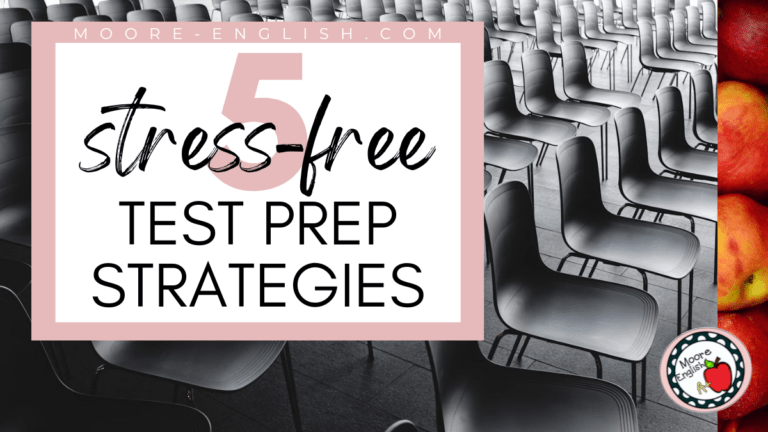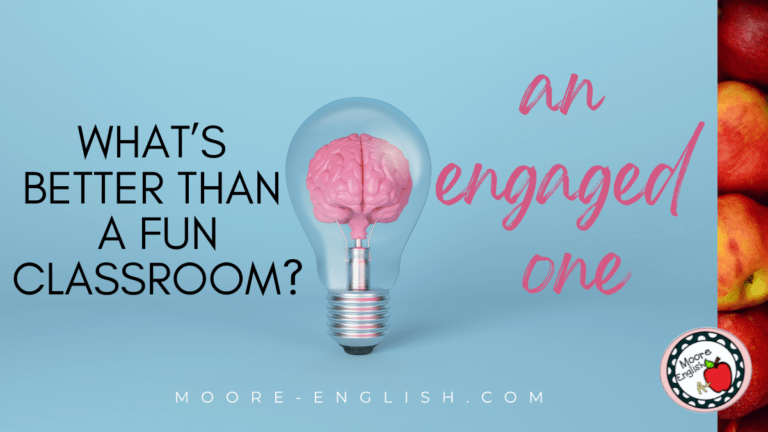In honor of March Madness, I thought I would share how I use brackets for student engagement! Using brackets is an easy way to engage students and encourage collaboration while also keeping the dialogue organized. Most importantly, brackets give me quick formative insights into student work. So I put together my three suggestions for using brackets and my three favorite bracket activities.
This post this post may contain affiliate links. Please read the Terms of Use.
Bracket Use Suggestions
Plan Ahead: As always, a lesson is always best when you plan ahead. First, know how and why you are going to use a bracket. Then, have the template you want ready to go. Next, make sure you know how you will facilitate the competition. Are you going to give a prize, or is winning itself the prize? Usually, I make this choice based on the group of students I have.
Work Short And Sweet: First, put a word/space and time limit on the responses you get. Start by giving students a sticky note to write on. This will limit the amount of space they can use and will stick neatly to the bracket. Additionally, I usually put my students on a 2-5 minute “shot clock.” Because of this, students stay focused, invested, and produce genuine work without resorting to Google. Further, a shorter time frame also limits opportunities for trash talk. Overall, keeping this activity brief makes it a formative experience rather than the totality of a lesson.
Collaborate: Because brackets have limited space and because I usually give students a short time in which to work, I almost always ask them to compete in partners. This encourages students to collaborate and bounce ideas off one another, refining their knowledge and skill along the way.
Bracket Activities
Collaborative Definitions: In my World Literature class, one of the first things the class needs to do is develop a definition of “world literature.” After doing a short reading (get the freebie here), students break in to partners and write their own definition of “world literature.” Then, we post the definitions on the board and compete head to head. As the class eliminates some options and advances others, they discuss which elements of a definition they valued, which seemed illogical, and which just needed some redefinition.
In the end, we usually have a definition that is parts of several different definitions. In particular, this activity gives the class a common language. Therefore, any time we’re discussing “world literature,” we’re using our classroom definition. And this strategy could be adapted to any situation in which students need to build a classroom definition, including words like “discussion”, “democracy”, “rhetoric”, or “literature.”
Concise Summary: Part of the ELA CCSS 9-10/11-12 RL.1 standard is producing objective summary. In particular, my students struggle to create a concise summary. For this reason, after doing a reading, students will break into partners. Next, I’ll give each partnership a sticky note. Then, I will ask them to provide a summary of the reading as if it were a tweet.
Oftentimes, we start with new twitter rules and 240 characters. Then, I challenge them to go even more concise with 120 characters; students LOVE this activity. Then, we bracket the summaries and put them head to head until with have one summary to rule them all. As we go through the summaries, we discuss what choices their peers made in terms of concision. Where could we be more concise? And where do we actually needed more information? To elaborate on this activity or bump it to the next level, I ask students to produce concise and objective summaries. All in all, this is a great tool for formative assessment!
Class Contests: In our Enlightenment Era unit, my juniors read about Benjamin Franklin’s use of aphorisms in anticipation of reading an excerpt from “The Crisis No. 1”, in which Thomas Paine uses aphorisms to argue in favor of the American Revolution. Over time, I’ve found that if students do not have some time to play around with their own aphorisms, they struggle to identify how Paine uses them. For this reason, I give students half of a sentence strip and ask them to compose their own aphorisms.
Once we bracket the aphorisms, students have a chance to discuss the strengths of each one and the weaknesses of others. And this kind of contest strategy could be used for any skill or concept students need to practice. For younger students, a contest practicing writing similes or using imagery would work, too.
Let us know your best formative strategies and ideas in the comments!








